Workshop "From Everyday Activities to Creative Tasks"
(Slide 1)
Topic of the Workshop: From Everyday Activities to Creative Tasks.
(Slide 2)
Aim: to give tips to teachers on intergrating creativity into everyday classroom practice and typical learning activities and exercises working with the language system.
(Slide 3)
Creativity is not for special days and not for a select few. It is for
-presenting and practising vocabulary,
-presenting and practising grammar,
-improving pronunciation.,
- developing speaking, writing, listening and reading.
I would like to show that small changes introduced step-by-step at different levels of teaching can gradually lead to a richer and more motivational, more creative learning environment for the learners and a more fulfilling, more rewarding teaching experience for the teachers. You will see how can the idea be used in different ways.
(Slide 4)
Improving pronunciation
(Slide 5)
Pronunciation is most often improved by recognition – repetition activities. Some form of this can be very playful, like using tongue twisters.
I use them as a warm-up activity at the beginning of the lesson. All together students repeat a tongue twister after a speaker, they vote for the tongue twister that they find the most challenging, we run a tongue-twister competition. And at last students compose their own ones.
And now I would like you listen to some tongue twisters, then repeat them after the speaker, afterwards decide which of them is the most challenging for you. (Task 1. To do repetition activity and vote for the tongue twister that is the most challenging.)
What are we going to do?
How are we going to do it?
How much time are we going to do this task?
Whether the weather be fine
Or whether the weather be not
Whether the weather be cold
Or whether the weather be not
We’ll weather the weather
Whatever the weather
Whether we like it or not.
Robert Rowley rolled a round roll round
A round roll Robert Rowley rolled round
If Robert Rowley rolled a round roll round
Where’s the round roll Robert Rowley rolled round?
(Task 2. To vote for the mosr challenging tongue twister.)The most challenging for you is the tongue twister about…
(Task 3. To run a tongue twister competition.) Let’s run a tongue twister competition.
What are we going to do?
How are we going to do it?
How much time are we going to do this task?
To do the practice with tongue twisters more creative and interesting teachers can prepare the task to put the lines together to make a tongue twister. You need to find the best order for the lines, and you can add to and take away from any line as you want. (Task 4. To do jig-saw tongue twisters.)
What are we going to do?
How are we going to do it?
How much time are we going to do this task?
(Slide 6)
Tricky Tristan tracked a trail of tiny turtles.
How many tiny turtles did Tricky Tristan track?
Tricky Tristan tracked twenty-two tiny turtles;
That’s how many tiny turtles tricky Tristan tracked.
(Slide 7)
While we were walking,
We were watching
window washers wash
Washington’s windows
With warm washing water.
One more creative task connected with tongue twister is to ask students to compose their own tongue twister. My students’ examples.
(Slides 8, 9)
(Slide 10)
Developing speaking
(Slide 11)
Typically, speaking activities fall into three categories:
1. Students talk about themselves. They are asked to share facts about themselves, their feelings, ideas, opinions, etc.
2. Students talk as someone else. They act and speak in a role. They receive some information about a situation, a problem, the character they are, etc. and they pretend to be that person in the given situation.
3. Students talk about someone or something else. They talk about a situation/story they are not part of.
Sometimes we ask our students to introduce themselves, to tell us different facts to get more information about them. We always have the plan of the story we would like to hear. But we should compose smth or to change smth. to make their stories more interesting and creative. I have two examples how to make the task more creative. This year my students of the 5th form got models of the hand. On each finger they wrote the key word or word combination to use in their sentences. First, they prepared sentences for the story about themselves, then they heard the number of the finger I called and put the question and gave the answer with the written words.
The 2nd example teachers can use with the senior students. Very small changes but the story about oneself becomes unusual. Teachers can create a lot of such plans.
We are going to tell about ourselves according to the given plan. Look at the screen.
(Slide 12)
What are we going to do?
How are we going to do it?
How much time are we going to do this task?
- Your 1st name.
- 4 adjectives
- Mother of/daughter of/father of/son of/ teacher of
- Who loves (3 things)
- Who is proud of (3 things)
- Who fears (3 things)
- Who would like to visit (3 things)
- Resident of
- Your surname
(Slide 13)
Presenting and practising vocabulary
(Slide 14)
When teaching vocabulary, we normally aim to help our students to connect the form of a word with its meaning. Students can get to the meaning if they come across the form (they see or hear the word) and when they have the meaning in mind they can say ithe word or write it.
When we present vocabulary, we provide the form, spoken and/or written, and give some guide to the meaning through a context, images, objects, mime, sounds and verbal clues or by creating a situation in which the meaning is clarified. Teachers try to find ways to clarify meaning without using the mother tongue so the students can do some more creative work.
We use a lot of games to learn the vocabulary. I would like to present you with one more. It is called “Dice Game’. We can’t shake these dice but we can roll them or throw. The number of spots on the side means the number of the task. You may change the task. Let’s see the rules in the slide.
(Slide 15)
Dice Game
1 – to give the definition (explain what it is/was)
2 – to draw the word
3 – to write a sentence
4 – does it have an opposite/a synonym?
5 – what is the word in your language?
6 – pick another word that starts with the same letter.
Which words to choose? Let’s take one noun, one verb and one adjective. E.g. a teacher / to work / pretty.
What are we going to do?
How are we going to do it?
How much time are we going to do this task?
(Slide 16)
New technology
Using Cross sense Technology
The name of this technology comes from two English words “cross” and “sense”. You can compare with the word “crossword’ (cross and word). In the last case we should find the words to solve/do the puzzle. In the 1st case we should find the sense. This technology was invented by Russian scientists. But it is popular among Ukrainian teachers. First this technology was described in 2002 and is considered new. It is very good for using at the lessons of literature, sciences, especially Biology, Health Education, etc.
(Slide 17)
Cross sense is a modern technology for learning with the help of visualization. It is a puzzle of the new generation which combines some intellectual tasks, the aim of which is to create the chain of associations with the help of pictures and not only. (when it is difficult for children to think logically with the help of the pictures teachers write words or sentences instead of pictures).
This technology is written a lot about.
To make “cross sense” teachers should prepare the field of 9 squares/parts. Each part is a picture with its own number written on the back/far side. (Or with the word or with the sentence).
To solve “cross sense’ you and your students should find associative connections of different types (very deep or vice versa very slight) between pictures in different ways. Some sources give examples of three ways to open the pictures. One more thing, the central card/picture #5 –is the topic of “cross sense”.
Here are the ways how to solve ‘cross sense’ according to one of the resources.
(Slide 18)
- 1-2; 2-3; 3-6; 6-9; 9-8; 8-7; 7-4; 4-5
- 1 2 3 4 6 7 8 9 5
- 1-2; 2-3; 3-6; 6-9; 9-8;8-7; 7-4; 4-1

(Slide 19)
Schemes on the board
Scheme #1. My Native Town. Form 5.
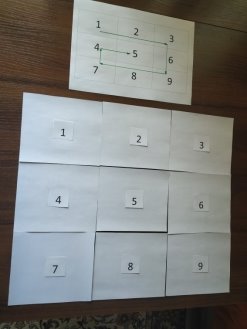
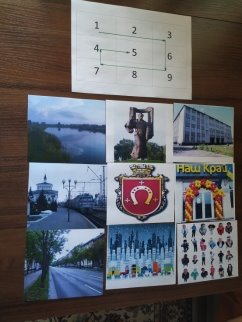
1 – Kovel stands on the river Turiya.
2 – There is a monument to Taras Shevchenko on the bank of the river.
3 – There are 13 schools in my town.
6 – There are also a lot of supermarkets, shops and churches in Kovel.
9 – More than 63 thousand people live in my town.
8 – The traffic in Kovel is heavy.
7 – The streets are wide, clean and green.
4 – Kovel is a big railway centre.
5 – I am proud of my native town and love it very much.
Scheme #2. My Working Day. Form 6.
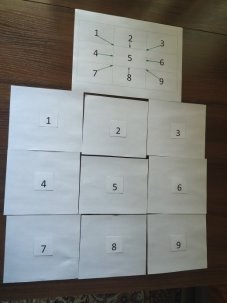
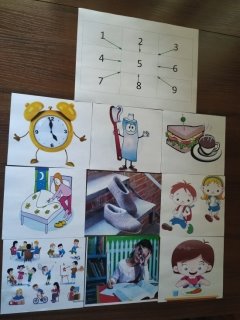
(Slide 20)
Scheme #3.Learning English with new technology. Form 11.
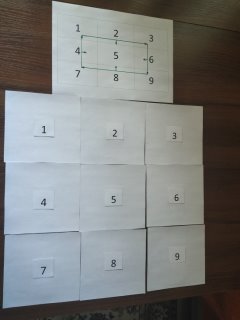
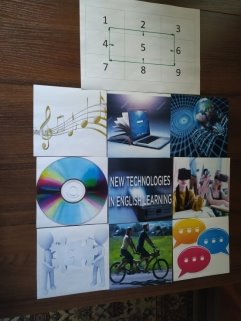
1 – New methods of learning English include e-learning, attending virtual classrooms, using tandem e-mail and using interactive CDs. E.g. CDs use a range of media, short film clips of typical scenes and situations, music, interactive quizzes and much more.
2 – E-learning means any kind of learning environment which is electronic.
3 – On the Internet there are countless sites dedicated to language learning such as worksheets you can download, interactive games, puzzles quizzes and so on.
6 – A day may come when we will sit in front of the computer, log on from home and “meet” our teacher and other learners in a “virtual” classroom.
9 – Virtual classrooms can use all the online resources available and usually use a type of chat room to practice oral communication.
8 – Another new method of language learning is tandem e-mail.
7 – You learn with a partner who is a native speaker of the language you are learning, but who is also learning your native language.
4 – Interactive language learning CDs offer learners a chance to work at their own speed and repeat vocabulary and phrases as often as they wish.
5 – The new media will play an increasingly important part in all learning and will complement traditional English teaching.
There are different ways to use cross sense at the lesson. E.g. to code the topic and to ask students to guess it. To make up the problem situation. To read the text and to keep in mind the context. To summarize the material. In practicing and revising the material. To check the hometask. To give the creative hometask. And even to demonstrate the lesson plan.
To my mind this method is close to the following ones: 1) work in small groups, 2) pair work, 3) brainstorm, 4) the circle of ideas, 5) microphone.
This method is not for putting bad marks and correcting strictly. Here you always have a chance to say that it’s your own idea, thank you but somebody else has another one and it is also correct and suitable. Different thinking is a way to inventions.
(Slide 21)
What are we going to do?
How are we going to do it?
How much time are we going to do this task?
Lesson Plan
1. Beginning of the lesson
2. Review
3. Presentation
4. Practice
5. Production
6. Revision
7. Home assignment
8. Summarizing
(Slide 22)
Doing these tasks students have a chance to share their experience and to use their imagination. They are an example of more creative alternatives to typical, everyday classroom exercises and procedures.
Finally, give me feedback on my workshop writing on the stickers short answers on the questions of the table on the board and stick them in the column.
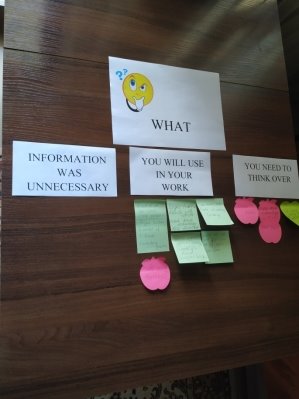
Thank you!
(Slide 23)


про публікацію авторської розробки
Додати розробку
